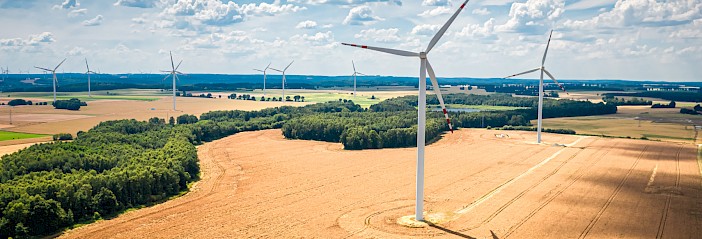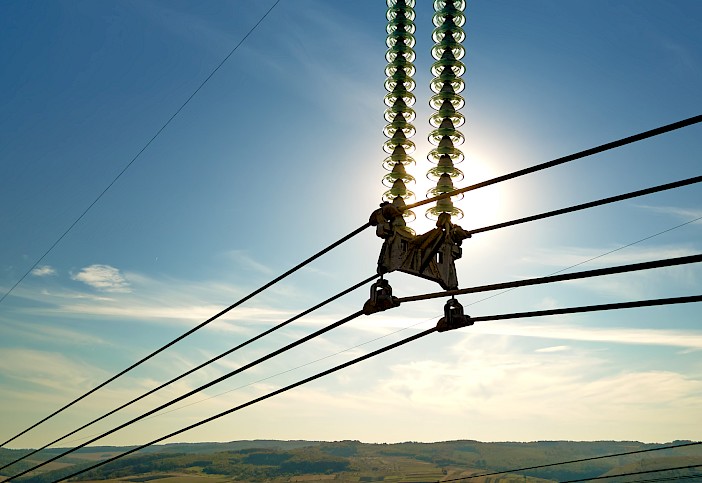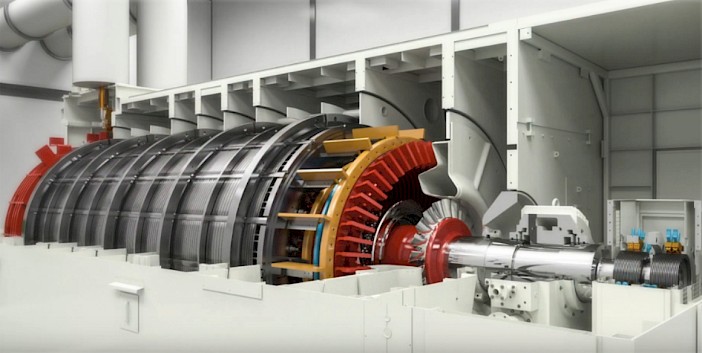The importance of inertia in electricity grids
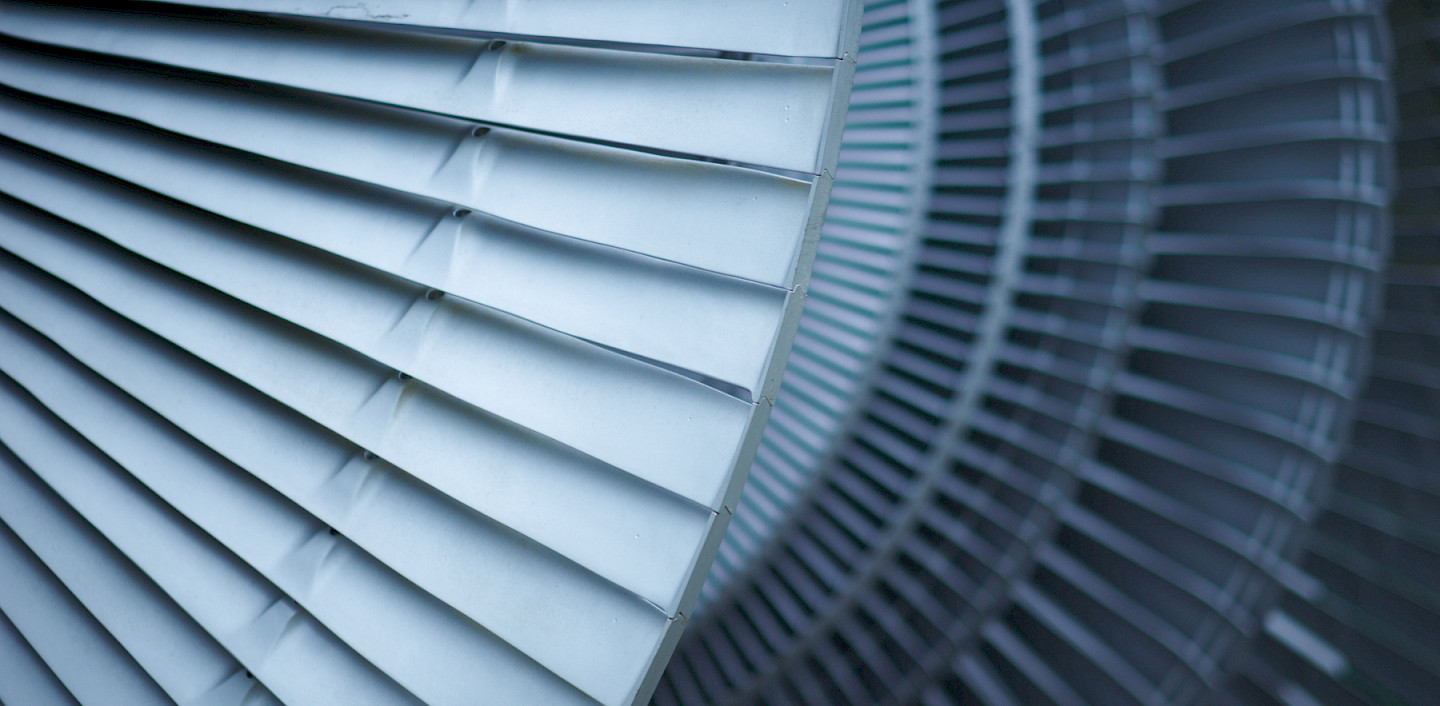
Most modern electricity grids use alternating current (thanks to the victory of Tesla over Edison in the so-called “Battle of the Currents” in the late 19th century….essentially, at the time the lower losses in an ac system allowed electricity to be transported more easily over larger distances).
Alternating currents arise from the rotation of a magnet inside another magnetic field – in a steam-driven generator, high pressure steam turns a turbine, which turns a rotor (also known as an armature) mounted inside a stator. A generator running at 3,000 revolutions per minute, with two magnetic poles, produces electricity at a frequency of 50 Hz (some systems such as in the US use turbines operating at 3,600 RPM to produce electricity at 60 Hz). The generator construction and its working principles define the shape and value of the induced voltage.
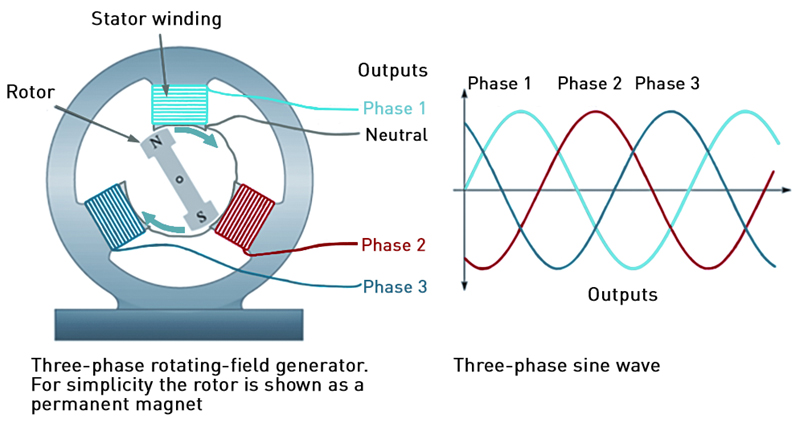
Generators convert the kinetic energy of the spinning turbines into electrical energy. The principle of conservation of energy governs the relationship between system power and the kinetic energy of the rotors – if there is insufficient supply to meet demand, the rotors will slow down and system frequency will fall, and vice versa. A sudden loss of generation or surge in demand and lead to a rapid change in frequency, which can damage equipment connected to the grid:
- Large frequency drops can damage transformers and induction motors due to the high magnetising currents required for maintaining flux. These devices are widely used in electricity transmission and distribution networks as well as in consumer appliances, so avoiding large frequency deviations is important to avoid damaging both network infrastructure and end-user devices;
- Turbine blades are designed to operate in a narrow band of frequencies to avoid mechanical vibrations of blades at their natural frequencies – operation outside this frequency range can damage the turbine;
- Drops in frequency cause the air flow in generators and turbines to fall, thus reducing cooling, while generator control systems increase their input power to maintain the generation and demand balance, which may result in an increase of the internal temperature of the turbine and generator windings – as the internal temperature increases, the protection devices cause the generator to disconnect from the grid, increasing the imbalance between demand and generation;
- Increases in generator power output can also overload transmission lines, causing them to trip.
For these reasons, system operators are required to maintain frequency within narrow limits and, if frequency deviates, to restore it to normal levels within a specified time period. In all global electricty grids, these requirements are part of the system operator’s licence conditions.
Variations in system demand are growing
The level of this challenge is illustrated by this chart which shows demand through the day on two days separated by 6 months. As you can see, winter demand is, as expected, higher than in summer when less heating and lighting is needed.
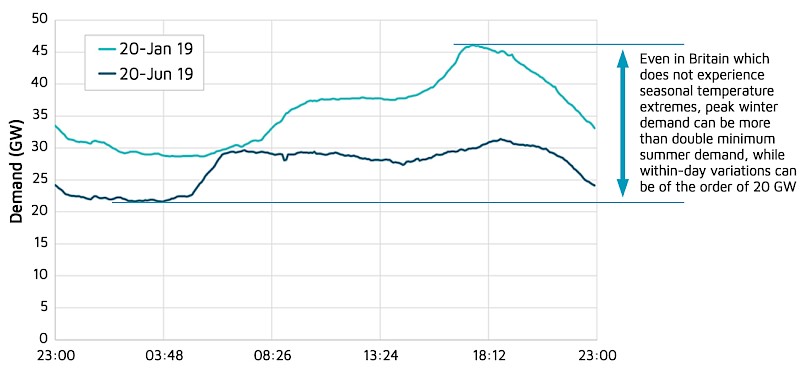
Demand also varies through the day with a strong peak in the evening as the nation comes home from work and cooks dinner, and low demand at night when people are sleeping.
Sometimes there are events that cause major demand spikes. One of the most famous of these happens at half time in the FA cup final….millions of people watch the cup final on live television, and at half time, many will open their fridges and put the kettle on causing a sudden and significant demand spike.
This phenomenon is known as “TV pickup” – one of the largest occurred on Wednesday, 4 July 1990 during the Football World Cup Semi Final between England and West Germany – around 26 million people in the UK watched the match and when England missed a penalty and went out of the competition many of these people headed to the kitchen. There was a 2,800 MW spike in demand – equivalent of about 1.12 million kettles.
The TV pickup phenomenon is particularly pronounced in the UK for a number of reasons: the country has historically had relatively few TV channels, so the many people might be watching the same programme at the same time; the British are famous tea drinkers so tend to turn on kettles to make tea at breaks between programmes, and almost exclusively use electric kettles to heat water unlike other countries where other technologies may be used. This effect has in fact reduced in recent years with the proliferation of satellite, cable TV and internet television, but its existence has played a significant role in the development of the grid and grid balancing approaches.
To meet these sudden spikes in demand, power stations that are capable of starting very quickly are kept on standby. These are known as super-peakers – operating predominantly in times of highest demand, and often include pumped hydro plants which can start up extremely fast.
Although we have limited amounts of pumped hydro in the UK, we do in fact have the largest such power station in Europe – the 1800 MW Dinorwig power station in Wales, consisting of 6 vertical turbines that can go from cold to full load in under 16 seconds.
Pumped hydro stations store electricity by pumping water into a high-level reservoir normally at night when demand is low, so prices are cheap. When the electricity is needed, the water is released from the high reservoir, through vertical turbines, driving them to generate electricity – unlike in thermal or nuclear power stations, gravitational potential energy rather than kinetic energy is converted to electrical energy.
Energy transition requires a different approach
Many countries around the world are transitioning their electricity systems from ones dominated by conventional fossil fuel and nuclear generation, where the large, heavy turbines described above rotate in synchronicity to generate electricity at the require frequency, to systems with higher proportions of intermittent renewable generation.
In a conventional electricity system, these large heavy turbines do not just generate electricity at the desired frequency, they inhibit changes in grid frequency through their physical characteristics: large, heavy objects are difficult to move, and changes to their movement. Energy is delivered to the turbine causing it to rotate at a constant speed – more energy is required to change that speed if the input energy remains constant. In this way, these turbines resist changes to grid frequency caused by fluctuations in supply and demand, a property which is known as “inertia”.
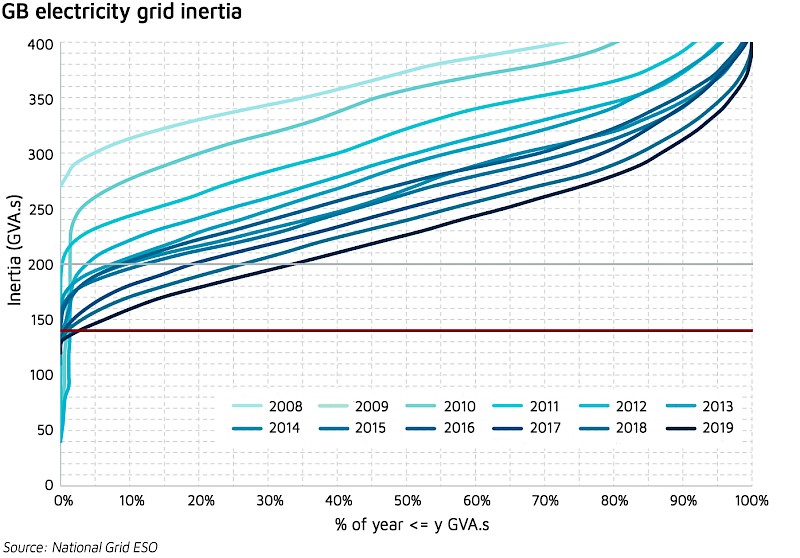
The growth in intermittent renewable generation disrupts system frequency in two ways:
- Intermittent renewable generation delivers an output that is highly variable in time. Wind speeds are rarely constant, changing in both intensity and direction by the second, and similarly cloud patterns can create significant, instantaneous variations in solar output. Changes in either generation or demand can lead to changes in grid frequency, so highly variable generation patterns make maintaining a stable grid frequency more difficult;
- Intermittent renewable generation is increasingly displacing conventional generation in the generation mix, reducing the amount of heavy, rotating turbines on the grid and therefore the amount of inertia they provide.
Operating the system with low inertia will continue to represent a key operational challenge into the future and we will need to ensure we improve our understanding of the challenges this will bring,
– National Grid ESO
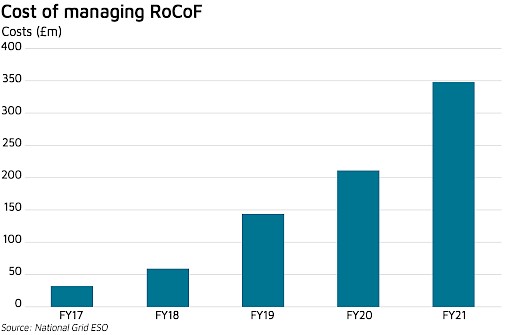 Taken together, these effects are making it increasingly difficult for system operators to maintain grid frequency, and in some regions such as South Australia, solar power is curtailed in order that gas generators can run, purely so that they can provide electricity at the correct frequency and deliver inertia to the grid.
Taken together, these effects are making it increasingly difficult for system operators to maintain grid frequency, and in some regions such as South Australia, solar power is curtailed in order that gas generators can run, purely so that they can provide electricity at the correct frequency and deliver inertia to the grid.
In Britain, the costs of managing grid frequency are rising sharply, as levels of inertia fall – National Grid ESO data show that the cost of managing the Rate of Change of Frequency (“RoCoF”) has risen by a factor of around 10 in just five years, to just under £350 million per year.
No doubt Thomas Edison would feel vindicated in his support for direct current, but as replacing existing grids would be unfeasibly expensive for the most part, grid operators are looking at different types of inertia provision that can support an systems with high levels of intermittent renewable generation. One approach is to deliver mechanical inertia through the use of synchronous condensers.
